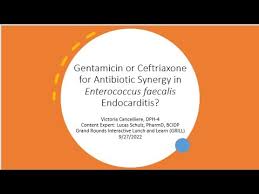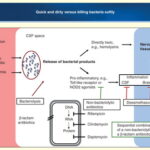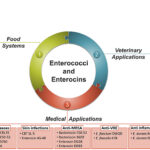Enterococcal endocarditis, predominantly caused by Enterococcus faecalis and Enterococcus faecium, is a severe manifestation of infective endocarditis (IE) characterized by high morbidity and therapeutic complexity. The intrinsic resistance of enterococci to many antimicrobial agents, combined with their ability to form biofilms on heart valves, necessitates a synergistic antibiotic approach for successful eradication.
Combination therapy—particularly involving cell wall-active agents with aminoglycosides—remains the cornerstone of effective treatment. This article presents a comprehensive overview of synergy for enterococcal endocarditis, emphasizing evidence-based antibiotic combinations and clinical management protocols.

Pathogenesis and Clinical Challenges
Enterococci are Gram-positive cocci that colonize the gastrointestinal tract and opportunistically cause endocarditis, especially in patients with prosthetic valves, prior cardiac conditions, or prolonged hospital stays.
Key Clinical Features:
- Persistent bacteremia
- New or changing heart murmur
- Signs of embolic phenomena
- Immunologic manifestations (e.g., Osler nodes, Roth spots)
Diagnostic Tools:
- Echocardiography (TEE preferred)
- Blood cultures (3 sets before antibiotics)
- Modified Duke Criteria for definitive diagnosis
Rationale for Synergistic Antibiotic Therapy
Due to limited bactericidal activity of monotherapy against Enterococcus spp., synergistic antibiotic combinations are essential. Synergy is defined as the enhanced effect of two antibiotics used together, leading to rapid bacterial killing and reduced resistance.
Mechanisms Behind Synergy:
- Beta-lactams (e.g., ampicillin) weaken the cell wall, facilitating aminoglycoside (e.g., gentamicin) entry into the cell.
- Double beta-lactam therapy (ampicillin + ceftriaxone) saturates different penicillin-binding proteins, boosting bactericidal activity.
Recommended Antibiotic Combinations
1. Ampicillin + Gentamicin
Indication: Fully susceptible Enterococcus faecalis strains
Mechanism: Cell wall inhibition + protein synthesis disruption
Duration: 4–6 weeks depending on native or prosthetic valve involvement
Monitoring: Renal function and aminoglycoside levels due to nephrotoxicity risk
2. Ampicillin + Ceftriaxone
Indication: Alternative for patients with renal impairment or high-level aminoglycoside resistance (HLAR)
Mechanism: Dual beta-lactam saturation of PBPs
Clinical Outcome: Non-inferior to gentamicin regimens in multiple studies
Duration: 6 weeks minimum
3. Vancomycin + Gentamicin
Indication: Beta-lactam allergy or resistant Enterococcus faecium
Consideration: High toxicity risk; use cautiously
Duration: 6 weeks
Limitation: Less synergistic than ampicillin-based regimens
4. Linezolid or Daptomycin (High Dose)
Indication: Multidrug-resistant E. faecium infections
Note: No proven synergy; used when other options fail
Combination Option: Daptomycin + Ceftaroline or Ampicillin for enhanced activity
Monitoring: Myelosuppression (linezolid), CPK levels (daptomycin)
Treatment Protocol by Clinical Scenario
| Condition | Regimen | Duration |
|---|---|---|
| Native Valve, Susceptible E. faecalis | Ampicillin + Gentamicin | 4–6 weeks |
| Prosthetic Valve, Susceptible | Ampicillin + Ceftriaxone | 6 weeks |
| HLAR Enterococcus | Ampicillin + Ceftriaxone | 6 weeks |
| Beta-lactam Allergy | Vancomycin + Gentamicin | 6 weeks |
| Multidrug-resistant E. faecium | Linezolid or Daptomycin-based combo | ≥6 weeks |
Managing High-Level Aminoglycoside Resistance (HLAR)
HLAR is defined by enterococci with MICs for gentamicin ≥500 μg/mL, eliminating synergy with aminoglycosides.
Preferred Approach:
- Ampicillin + Ceftriaxone: Proven effective against HLAR E. faecalis
- Avoid monotherapy due to slow bacterial killing and higher relapse rates
Monitoring and Adverse Effects
Due to potential toxicities, particularly nephrotoxicity and ototoxicity from aminoglycosides, close monitoring is essential:
- Gentamicin levels: Aim for peak 3–4 µg/mL, trough <1 µg/mL
- Renal function: Baseline and at least twice weekly
- CBC and LFTs: Especially with linezolid (bone marrow suppression) or daptomycin (eosinophilic pneumonia risk)
Surgical Considerations in Refractory Cases
Valve replacement should be considered in the following:
- Persistent bacteremia despite optimal therapy
- Valve dysfunction with heart failure
- Perivalvular abscess or prosthetic valve dehiscence
- Large vegetation (>10 mm) with embolic events
Clinical Outcomes and Prognosis
With appropriate synergy-driven therapy, cure rates for susceptible E. faecalis endocarditis exceed 80%. However, infections caused by multidrug-resistant E. faecium exhibit poorer outcomes and higher mortality. Prompt initiation of effective combination therapy and surgical intervention when indicated remain critical for survival.
The management of enterococcal endocarditis demands a strategy focused on synergistic antibiotic combinations, particularly for strains with resistance or in complex clinical contexts. By utilizing evidence-backed regimens—especially ampicillin with gentamicin or ceftriaxone—and ensuring rigorous monitoring, we can significantly improve patient outcomes and reduce relapse rates. Emerging resistance patterns underscore the need for ongoing research and antimicrobial stewardship in this challenging domain.

